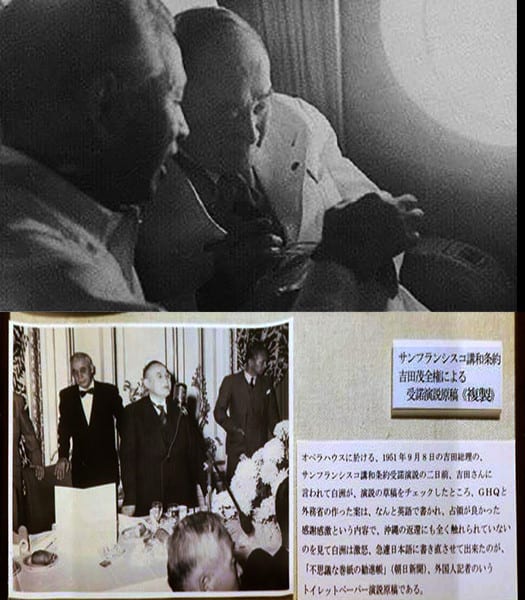
日本の歴史授業では明治以降の歴史はさらっとしかやらない。
現代に直接繋がる権力構造や、反政府勢力のありようなど、
あまりにも生々しい関係性がゴロゴロしているので触れにくいのでしょう。
住宅建築、それも現代まで残っている古民家などを探訪していると
けっこう容易にそういった歴史人間関係であるとかがうかがえて興味深い。
江戸期から明治期にかけては各地方で大地主として存続した豪農層と
明治期以降権力周辺で西洋の社会基盤の情報に強く接していた層が
「有力者層」を形成して日本資本主義の最初の成功者になっていく。
明治最初期のわかりやすい成功者は絹糸産業の主たちであり
横浜から海外輸出される交易の富は莫大だったと言われる。
よく函館では北前交易で儲かった人々はその後横浜に移って
海外交易での成功者になった。結果、函館には資産家の積層は残らなかったと。
そうした層の豪邸が「残すべき資産」として現代にまで残っている。
戦前期まではこれらの層が「支配階層」を形成して
欧米からの資本主義導入・キャッチアップで有利な立場を築いていた。
この白洲次郎氏の来歴をみると家系が明治期に貿易で大成功し、
そして有力家系同士で婚姻関係を形成して人間情報の紐帯を太くしている。
戦前期に白洲次郎自身はイギリス・ケンブリッジに留学し、
その親はアメリカ・ハーバードに留学している。貿易商として重要な人脈を
海外で築いている様子が明瞭に見て取れる。
父親は綿貿易で巨万の富を築いたけれど要するにそうした人脈情報で
圧倒的な「格差」があって、それを非競争的原資にしたことがわかる。
白洲家の会社は昭和初期に倒産しているけれど、その後も息子の次郎氏は
ポンと外車を父親からプレゼントされたりしている。
そしてそういった貿易事業と不可欠な人脈開拓で英国大使時代の
後の総理・吉田茂と知遇を得たりしている。イギリス出張の際には
なんと日本大使館を定宿にしていたというのだから、官民癒着はすごい。
経済規模に於いて英米と新興国日本ではまったくスケールが違い、
新興国としてはとにかく官民の境なく、キャッチアップに励んでいた。
そういう開明的な人士たちにすれば戦争に突入していった祖国の政治状況は
まさに「敗戦必至」と見通していたのだろう。

写真はサンフランシスコ講和会議に向かう機上での吉田茂と白洲次郎。
そのような出自の白洲次郎は占領軍のアメリカ側から
「日本人で稀な原理原則を主張する硬骨漢」とみなされたという。
講和交渉でも日本の立場を強くリードしたとされる。
「アメリカででも成立しない夢想的憲法」と占領軍の憲法押しつけを批判的に語る。
対米交渉の現場で生々しい経緯があっただろうけれど、
そういった書類は死の直前時期に焼却処分されたと娘さんの証言もあると。
英米をよく知る官民の中間的存在として「戦後」骨格形成に深い足跡を残した。
いま私達は、そのはるかな桎梏の中にいるのだと思う。
English version⬇
【What is the Japanese ruling class that leads to the present age? Buaisou-2】
In Japanese history lessons, the history after the Meiji era is only lightly done.
The power structure that is directly connected to the present age, the existence of rebels, etc.
It's hard to touch because the relationship is so vivid.
When you are exploring residential architecture, old folk houses that remain until the present day
It is interesting to see that it is such a historical human relationship quite easily.
From the Edo period to the Meiji period, with the wealthy farmers who survived as landlords in each region
Since the Meiji era, the people who have been in close contact with information on Western social infrastructure around power
Forming a "major class" and becoming the first successful Japanese capitalist.
The easy-to-understand successes of the early Meiji era were the masters of the silk industry.
It is said that the wealth of trade exported overseas from Yokohama was enormous.
People who often made money from the Kitamae trade in Hakodate then moved to Yokohama.
Became a successful foreign trader. As a result, there was no accumulation of wealthy people in Hakodate.
The mansion of such a class remains as an "asset to be left" to the present day.
Until the prewar period, these layers formed the "ruling class".
He was in an advantageous position by introducing and catching up with capitalism from Europe and the United States.
Looking at the history of Mr. Jiro Shirasu, the family line was a great success in trade during the Meiji era.
And they form a marriage relationship between influential families and thicken the ties of human information.
Before the war, Jiro Shirasu himself studied abroad in Cambridge, England, and
His parents are studying abroad in Harvard, USA. An important network as a trader
You can clearly see how he is building abroad.
His father made a huge fortune in the cotton trade, but in short, with such network information
It can be seen that there is an overwhelming "gap" and that it was used as a non-competitive resource.
The Shirasu family's company went bankrupt in the early Showa period, but his son Jiro continued to do so.
His father gave him a pong and a foreign car.
And with such a trading business and indispensable network development, during the time of the British Ambassador
He has been treated with the later Prime Minister, Shigeru Yoshida. When traveling to the UK
It is said that he had settled at the Japanese embassy, so his public-private cohesion is amazing.
In terms of economic scale, the scale is completely different between Britain and the United States and Japan, an emerging country.
As an emerging country, I was trying to catch up without any boundaries between the public and private sectors.
For such open-minded people, the political situation in their homeland that entered the war
It must have been predicted that "the defeat is inevitable".
The photo shows Shigeru Yoshida and Jiro Shirasu on the plane heading to the San Francisco Peace Conference.
Jiro Shirasu of such origin is from the American side of the occupation army
He is said to have been regarded as "a bony fish who insists on rare principles in Japan."
He is said to have strongly led Japan's position in peace negotiations.
He criticizes the occupying forces for imposing a constitution, saying that it is a "fantasy constitution that cannot be established even in the United States."
There must have been a vivid history in the field of negotiations with the United States,
According to his daughter's testimony, such documents were incinerated shortly before his death.
As an intermediary between the public and private sectors who are familiar with Britain and the United States, he left a deep mark on "postwar" skeletal formation.
I think we are in that far-off box now.










